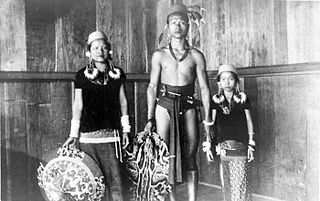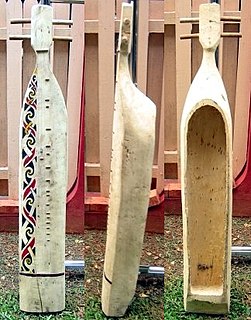Related Research Articles

Being an indigenous tribe in Borneo, the Kayan people are similar to their neighbours, the Kenyah tribe, with which they are grouped together with the Bahau people under the Apo Kayan people group. The Kayan people are categorised as a part of the Dayak people. They are distinct from, and not to be confused with, the Kayan people of Myanmar.

Miri Division is one of the twelve administrative divisions of Sarawak, Malaysia. It has a total area of 26,777.1 square kilometres, and is the second largest division after Kapit Division. The seat of this division is the city of Miri.

Mandau is the traditional weapon of the Dayak people of Borneo. It is also known as Parang Ilang among the Bidayuh, Iban and Penan people, Malat by the Kayan people or Baieng by the Kenyah people or Bandau by Lun Bawang or Pelepet/Felepet by Lundayeh. Mandau is mostly ceremonial. However, a less elaborate version called Ambang is used as an everyday practical tool.

Marudi is a town in the Malaysian state of Sarawak. It is located on the banks of Baram River, about 100 kilometres (62 mi) upstream from the river mouth. Marudi was the administrative centre of the northern region of Sarawak before Miri was established. It is the cultural heart of the Orang Ulu, the highland tribes of Sarawak. It is a transit gateway to Gunung Mulu National Park, a UNESCO World Heritage Site.

The Kenyah people are an indigenous, Austronesian-speaking people of Borneo, living in the remote Baram Lio Matoh, Long Selaan, Long Moh, Long Anap, Long Mekaba, Long Jeeh, Long Belaong, Long San, Long Silat, Long Tungan, Data Kakus, Data Surau, Senap River, Long Dungan, Long Busang, Long Beyak, Tubau, Bintulu, Miri, Apau Koyan resettlement for Bakun Dam, Long Bulan, Long Jawe, Dangang, Long Bangan, Long Urun, Sambop Long Semutut, Long Tebulang, Long Lawen, Long Unan and Belaga regions in Sarawak, Malaysia and the remote Apau Kayan, Bahau (Bau), Benua Lama, Benua Baru and Mahakam regions in East Kalimantan, Indonesia.
The Uma Baka' tribe were originally from the rural center of Borneo Island. Originally from Bahau River, the Uma Baka' people began moved out from that river system along with the Uma' Kulit people in the 18th century. Although the tribe still remains in East Kalimantan, Indonesia, some of them have moved to Sarawak, Malaysia. The tribe was known as the best hunters in jungle. The Uma Baka' people are considered as a sub-ethnic of the Kenyah people and their language is Uma Baka' language, which is a form of Kenyah language dialect.
The Kayanic or Kayan–Murik languages are a group of Austronesian languages spoken in Borneo by the Kayan, Morek Baram, Bahau, and related peoples.
The Melanau–Kajang languages or Central Sarawak languages are a group of languages spoken in Sarawak, Malaysia, by the Melanau, Kenyah, and related peoples.
The Kenyah languages are a group of half a dozen or so closely related languages spoken by the Kenyah peoples of Borneo. They are:
The North Sarawakan languages are a group of Austronesian languages spoken in the northeastern part of the province of Sarawak, Borneo, and proposed in Blust.

The sape' is a traditional lute of the Kenyah and Kayan community who live in the longhouses that line the rivers of East Kalimantan and North Kalimantan, Indonesia and Northern part of Sarawak, Malaysia. Sape' are carved from a single bole of wood, with many modern instruments reaching over a metre in length.
Penan, also known as Punan-Nibong, is a language complex spoken by the Penan people of Borneo. They are related to the Kenyah languages. Glottolog shows Western Penan as closer to Sebop than it is to Eastern Penan.
Mainstream Kenyah also known as Usun Apau and Bakung, is a Kayan dialect cluster of North Kalimantan and Sarawak. Dialects fall into four clusters:
Tutoh, also known as Long Wat, is a Kenyah language of Sarawak, spoken along the Tutoh River. It is spoken in the villages of Long Wat and in the Bornean city of Miri, where however most are shifting to Malay.
Sebob is a Kenyah language of Sarawak.
Umaʼ Lasan is a Kayan language of Borneo. Umaʼ Lung is marginally intelligible with the other varieties.
Kancet Papatai is a traditional Indonesian war dance about a war hero and his struggle against the enemy. The dance also describes his courage and the ceremony awarding him the title Ajai, for his victory.

The Apo Kayan people are one of the Dayak people groups that are spread throughout Sarawak of Malaysia, East Kalimantan and North Kalimantan of Indonesia. The earliest Apo Kayan people are from the riverside of the Kayan River, Bulungan Regency, East Kalimantan, Indonesia. According to the Apo Kayan Dayak legend, the Kayan people are the forefathers of which all smaller sub-ethnic Dayak people that are found along the Kayan River came from. Today, the population of the Apo Kayan people are estimated about 64,900.
The Lebbo' people are part of the indigenous Dayak people of East Kalimantan province, Indonesia. They generally regard themselves as a subgroup of the Kenyah people.

Bukit Mabong is a district, in Kapit Division, Sarawak, Malaysia.
References
- ↑ Wahau Kenyah at Ethnologue (18th ed., 2015)